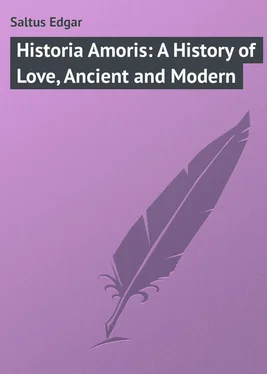Edgar Saltus - Historia Amoris - A History of Love, Ancient and Modern
Здесь есть возможность читать онлайн «Edgar Saltus - Historia Amoris - A History of Love, Ancient and Modern» — ознакомительный отрывок электронной книги совершенно бесплатно, а после прочтения отрывка купить полную версию. В некоторых случаях можно слушать аудио, скачать через торрент в формате fb2 и присутствует краткое содержание. Жанр: foreign_prose, Зарубежные любовные романы, на английском языке. Описание произведения, (предисловие) а так же отзывы посетителей доступны на портале библиотеки ЛибКат.
- Название:Historia Amoris: A History of Love, Ancient and Modern
- Автор:
- Жанр:
- Год:неизвестен
- ISBN:нет данных
- Рейтинг книги:4 / 5. Голосов: 1
-
Избранное:Добавить в избранное
- Отзывы:
-
Ваша оценка:
- 80
- 1
- 2
- 3
- 4
- 5
Historia Amoris: A History of Love, Ancient and Modern: краткое содержание, описание и аннотация
Предлагаем к чтению аннотацию, описание, краткое содержание или предисловие (зависит от того, что написал сам автор книги «Historia Amoris: A History of Love, Ancient and Modern»). Если вы не нашли необходимую информацию о книге — напишите в комментариях, мы постараемся отыскать её.
Historia Amoris: A History of Love, Ancient and Modern — читать онлайн ознакомительный отрывок
Ниже представлен текст книги, разбитый по страницам. Система сохранения места последней прочитанной страницы, позволяет с удобством читать онлайн бесплатно книгу «Historia Amoris: A History of Love, Ancient and Modern», без необходимости каждый раз заново искать на чём Вы остановились. Поставьте закладку, и сможете в любой момент перейти на страницу, на которой закончили чтение.
Интервал:
Закладка:
Saltus Edgar
Historia Amoris: A History of Love, Ancient and Modern
PART I
I
SUPER FLUMINA BABYLONIS
The first created thing was light. Then life came, then death. In between was fear. But not love. Love was absent. In Eden there was none. Adam and Eve emerged there adult. The phases of the delicate fever which others in paradise since have experienced, left them unaffected. Instead of the reluctances and attractions, the hesitancies and aspirations, the preliminary and common conflagrations which are the beginnings, as they are also the sacraments, of love, abruptly they were one. They were married before they were mated.
The union, entirely allegoric – a Persian conceit – differed, otherwise, only in the poetry of the accessories from that which elsewhere actually occurred.
Primitive man was necessarily speechless, probably simian, and certainly hideous. Women, if possible more hideous still, were joined by him momentarily and immediately forgot. Ultimately, into the desolate poverty of the rudimentary brain there crept a novelty. The novelty was an idea. Women were detained, kept in lairs, made to serve there. Further novelties ensuing, creatures that had learned from birds to talk passed from animality. Subsequent progress originated in a theory that they were very clearly entitled to whatever was not taken away from them. From that theory all institutions proceed, primarily that of family.
In the beginning of things woman was common property. With individual ownership came the necessity of defence. Man defended woman against even herself. He beat her, stoned her, killed her. From the massacre of myriads, constancy resulted. With it came the home: a hut in a forest, a fort on a hill, in the desert a tent, yet, wherever situated, surrounded by foes. The foes were the elements. In the thunderclap was their anger. In the rustle of leaves their threats. They were placatable, however. They could be appeased, as human beings are, by giving them something. Usually the gift was the sacrifice of whatever the owner cared for most; in later days it was love, pleasure, sense, but in these simpler times, when humanity knew nothing of pleasure, less of love, and had no sense, when the dominant sensation was fright, when every object had its spectre, it was accomplished by the immolation of whatever the individual would have liked to have had given to him. As intelligence developed, distinctions necessarily arose between the animate and the inanimate, the imaginary and the real. Instead of attributing a malignant spirit to every element, the forces of nature were conglomerated, the earth became an object of worship, the sun another, that being insufficient they were united in nuptials from which the gods were born – demons from whom descended kings that were sons of heaven and sovereigns of the world.
In the process, man, who had begun by being a brute, succeeded in becoming a lunatic only to develop into a child. The latter evolution was, at the time, remote. Only lunatics abounded. But lunatics may dream. These did. Their conceptions produced after-effects curiously profound, widely disseminated, which, first elaborated by Chaldæan seers, Nineveh emptied into Babylon.
Babylon, Queen of the Orient, beckoned by Semiramis out of myth, was made by her after her image. That image was passion. The city, equivocal and immense, brilliant as the sun, a lighthouse in the surrounding night, was a bazaar of beauty. From the upper reaches of the Euphrates, through great gates that were never closed, Armenia poured her wines where already Nineveh had emptied her rites. In the conjunction were festivals that magnetized the stranger from afar. At the very gates Babylon yielded to him her daughters. He might be a herder, a bedouin, a bondman; indifferently the voluptuous city embraced him, lulled him with the myrrh and cassia of her caresses, sheltering him and all others that came in the folds of her monstrous robe.
In emptying rites into this furnace Nineveh also projected her gods, the princes of the Chaldæan sky, the lords of the ghostland, that, in patient perversities, her seers had devised. Four thousand of them Babylon swallowed, digested, reproduced. Some were nebulous, some were saurian, many were horrible, all were impure. But, chiefly, there was Ishtar. Semiramis conquered the world. Ishtar set it on fire.
Ishtar, whom St. Jerome generically and graphically described as the Dea Meretrix, was known in Babylon as Mylitta. Gesenius, Schrader, Münter, particularly Quinet, have told of the mysteries, Asiatically monstrous, naïvely displayed, through which she passed, firing the trade routes with the flame of her face, adding Tyrian purple and Arabian perfumes to her incandescent robe, trailing it from shore to shore, enveloping kingdoms and satrapies in her fervid embrace, burning them with the fever of her kisses, burning them so thoroughly, to such ashes, that to-day barely the memory of their names endures; multiplying herself meanwhile, lingering there where she had seemed to pass, developing from a goddess into a pantheon, becoming Astarte in Syria, Tanit in Carthage, Ashtaroth in Canaan, Anaïtis in Armenia, yet remaining always love, or, more exactly, what was love in those days.
In Babylon, fronting her temple was a grove in which were dove-cotes, cisterns, conical stones – the emblems of her worship. Beyond were little tents before which girls sat, chapleted with cords, burning bran for perfume, awaiting the will of the first that put a coin in their lap and in the name of the goddess invited them to her rites. Acceptance was obligatory. It was obligatory on all women to stop in the grove at least once. Herodotus, from whom these details are taken, said that the sojourn of those that were fair was brief, but others less favored lingered vainly, insulted by the former as they left. 1 1 Herodotus, I., 199.
Herodotus is father of history; perhaps too, father of lies. But later Strabo substantiated his story. There is anterior evidence in the Bible. There is antecedent testimony on a Nineveh brick. There is the further corroboration of Justinus, of St. Augustin, and of Eusebius regarding similar rites in Armenia, in Phœnicia, in Syria, wherever Ishtar passed. 2 2 Strabo, XVI., xi., 532. Baruch, VI. Justinus, XVIII. St. Augustin: Civit. Dei, IV., 10. Eusebius: Vita Constantini, III., 53-56. Cf. Juvenal, Satir. 9: Nam quo non prostat femina templo?
The forms of the ceremony and the duration of it varied, but the worship, always the same, was identical with that of the Hindu bayaderes, the Kama-dasi, literally servants of love, more exactly servants of lust, who, for hire, yielded themselves to any comer, and whose dishonorarium the clergy took.
From Phœnicia the worship passed to Greece. Among local articles of commerce were girls with whom the Phœnicians furnished harems. One of their agencies was at Cythera. From the adjacent waters Venus was rumored to have emerged. The rumor had truth for basis. But the emergence occurred in the form of a stone brought there on a Phœnician galley. The fact, cited by Maximus Tyrius, numismatics confirm. On the old coins of Paphos it was as a stone that Venus appeared, a stone emblematic and phallic, similar to those that stood in the Babylon grove.
Venus was even otherwise Phœnician. In Semitic speech girls were called benoth , and at Carthage the tents in which the worship occurred were termed succoth benoth . In old texts B was frequently changed to V. From benoth came venoth and the final theta being pronounced, as was customary, like sigma, venos resulted and so appears on a Roman medal, that of Julia Augusta, wife of Septimius Severus, where Venus is written Venos.
Meanwhile on the banks of the Indus the stone reappeared. Posterior to the Vedic hymns, it is not mentioned in them. Instead is the revelation of a being purer than purity, excelling excellence, dwelling apart from life, apart from death, ineffably in the solitudes of space. He alone was. The gods were not yet. They, the earth, the sky, the forms of matter and of man, slept in the depths of the ideal, from which at his will they arose. That will was love. The Mahabhârata is its history.
Читать дальшеИнтервал:
Закладка:
Похожие книги на «Historia Amoris: A History of Love, Ancient and Modern»
Представляем Вашему вниманию похожие книги на «Historia Amoris: A History of Love, Ancient and Modern» списком для выбора. Мы отобрали схожую по названию и смыслу литературу в надежде предоставить читателям больше вариантов отыскать новые, интересные, ещё непрочитанные произведения.
Обсуждение, отзывы о книге «Historia Amoris: A History of Love, Ancient and Modern» и просто собственные мнения читателей. Оставьте ваши комментарии, напишите, что Вы думаете о произведении, его смысле или главных героях. Укажите что конкретно понравилось, а что нет, и почему Вы так считаете.












